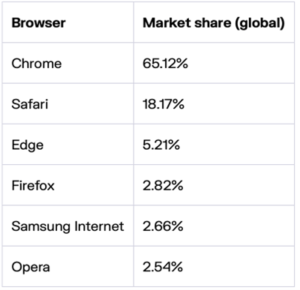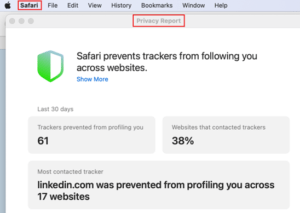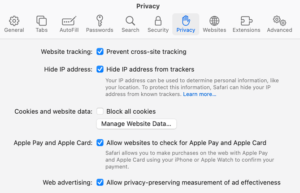Daniel Kwaku Ntiamoah ADDAI
In this age of technological advancement, people spend a significant portion of their lives online. From work-related tasks and online shopping to entertainment and social interactions, the internet has become an integral part of daily life.
At the core of this digital experience is the web browser—our gateway to the vast resources of the internet. Web browsers have become the indispensable tool for accessing information, connecting with others, and engaging with a wide array of online services.
As the primary interface between users and the internet, web browsers serve as the eyes through which we explore the web. Their importance has made them the go-to tool for millions of users worldwide. A web browser is a software application designed to retrieve, present, and traverse information on the World Wide Web. These browsers have evolved to include various features aimed at maximizing the online experience, such as tabbed browsing, extensions, and personalized settings. These innovations have made web browsers more than just tools—they are now central to how we experience and interact with the digital world.
When examining the most popular web browsers, statistics show a clear preference for a few key players. Google Chrome, Safari, Microsoft Edge, Mozilla Firefox, and Opera dominate the market, each offering a unique combination of speed, functionality, and user-friendliness (Statcounter, May 2024)

While these browsers provide a seamless and enriched browsing experience, not all of them prioritize security to the same extent. This discrepancy leaves users vulnerable to various cyber threats, as some browsers focus more on delivering a superior user experience at the expense of robust security features.
With this, it is crucial to choose a secure web browser as your first line of cyber defence. In this article, we will explore the reasons why selecting a secure browser is essential for safeguarding your online activities and personal information. With cyber threats on the rise, understanding the importance of a secure browsing experience is more critical than ever.
The evolution of browser security
The history of web browsers is not just a story of innovation and enhanced user experience but also a tale of ongoing battles against cyber threats. When web browsers first emerged in the early 1990s, they were relatively simple tools designed to access and display information from the World Wide Web. Security concerns were minimal, as the web was in its infancy, and the potential for cyber threats was largely underestimated. Early browsers like Mosaic and Netscape Navigator focused primarily on usability and accessibility, with little emphasis on protecting users from malicious activities.
However, as the internet evolved into a global platform for commerce, communication, and information exchange, the role of web browsers expanded significantly. They were no longer just interfaces for accessing information; they became repositories of critical data about users and the websites they visited. Modern browsers store a vast amount of sensitive information, including passwords, browsing history, cookies, and autofill data, making them prime targets for cybercriminals. This shift in functionality has necessitated a corresponding evolution in browser security.
As web browsers grew in complexity, so did the nature of the attacks they faced. Cybercriminals began exploiting vulnerabilities in browsers to perpetrate various types of attacks, such as phishing, drive-by downloads, cross-site scripting (XSS), and man-in-the-middle attacks. These attacks often aimed to steal sensitive information, install malware, or hijack browsing sessions. For instance, phishing attacks use deceptive websites to trick users into divulging personal information, while XSS exploits vulnerabilities in web applications to inject malicious scripts that can capture user data or redirect users to harmful sites.
In response to these escalating threats, web browsers have introduced a range of security features designed to protect users and their data. Modern browsers now include built-in phishing and malware protection, which block access to known malicious sites. Secure browsing modes, such as Google Chrome’s ‘Incognito Mode’ or Firefox’s ‘Private Browsing’, help users protect their privacy by not storing browsing history, cookies, or site data. Furthermore, features like sandboxing isolate each browser tab or process to prevent malware from spreading across the system.
Another critical development in browser security is the implementation of HTTPS (Hypertext Transfer Protocol Secure), which encrypts data exchanged between the user’s browser and the websites they visit. This encryption ensures that even if data is intercepted, it remains unreadable to unauthorized parties. Browsers now also support Content Security Policy (CSP), which helps prevent XSS attacks by restricting the resources that can be loaded on a webpage.
These advancements underscore the importance of selecting a secure browser. As the first line of defence in the fight against cyber threats, browsers must be equipped with robust security features to protect users’ personal and financial information.
Browser vulnerabilities and the importance of regular updates
Web browsers, while essential for navigating the internet, have also been at the centre of significant security breaches over the years. These vulnerabilities have exposed users to a range of cyber threats, emphasizing the need for continuous updates and vigilant security practices.
Notable browser vulnerabilities
-
Spectre and Meltdown (2018): These vulnerabilities exploited speculative execution in modern processors, allowing attackers to access sensitive data stored in memory. Web browsers were particularly at risk as they are frequently used to access sensitive information. Browser vendors quickly released patches to mitigate these vulnerabilities, highlighting the importance of keeping browsers up to date.
-
Heartbleed (2014): Although primarily a vulnerability in the OpenSSL library, Heartbleed had significant implications for web browsers. It allowed attackers to steal information normally protected by the SSL/TLS encryption used to secure the internet. Browsers had to be updated to handle SSL/TLS connections more securely and to avoid exposing sensitive data.
-
Every year, security researchers and hackers reveal critical zero-day vulnerabilities in popular browsers like Chrome, Firefox, and Edge. These vulnerabilities often involve remote code execution or privilege escalation, allowing attackers to take control of the victim’s machine. The immediate response from browser vendors to patch these vulnerabilities underscores the dynamic nature of web threats.
These incidents underscore why users must continually update their browsers. Outdated browsers lack the latest security patches, making them more susceptible to exploits.
Key considerations when choosing a browser
When selecting a browser for your web experience, consider the following factors:
-
Security features: Look for browsers that offer robust security features, such as built-in phishing and malware protection, HTTPS enforcement, sandboxing, and regular security updates.
-
Privacy controls: Choose a browser that prioritizes user privacy, offering features like tracking protection, private browsing modes, and control over cookie settings.
-
Performance and speed: Consider how quickly the browser loads pages and handles multiple tabs. While security is paramount, a balance with performance is necessary for a smooth browsing experience.
-
Compatibility: Ensure the browser is compatible with the websites and web applications you frequently use. Some browsers may offer better support for certain web standards or technologies.
-
User experience: Evaluate the browser’s interface and ease of use. Features like customizable toolbars, extensions, and themes can enhance the browsing experience.


Configuring your browser for enhanced security
Once you’ve selected a browser, configuring it correctly is crucial to maximizing security.
Here are some fundamental steps:
-
Enable automatic updates: Ensure your browser is set to update automatically, so you always have the latest security patches.
-
Activate do not track: Enable the “Do Not Track” feature to request that websites do not track your browsing activity.
-
Disable third-party cookies: Prevent tracking by disabling third-party cookies in your browser settings.
-
Use HTTPS-only mode: Activate a setting that enforces HTTPS connections wherever possible, ensuring data is encrypted during transmission.
-
Install security extensions: Consider adding reputable security extensions like ad blockers, anti-tracking tools, and script blockers to further enhance your browser’s security.

Best practices for safe web browsing
In addition to configuring your browser, here are some practices to ensure a safe browsing experience:
-
Be cautious with links: Avoid clicking on suspicious links in emails, social media, or unfamiliar websites. Hover over links to preview the URL before clicking.
-
Use strong, unique passwords: Utilize a password manager to create and store complex passwords for different accounts, reducing the risk of credential theft.
-
Enable Two-Factor Authentication (2FA): Where possible, enable 2FA on your online accounts for an extra layer of security.
-
Regularly clear browsing data: Periodically clear your browser’s cache, cookies, and browsing history to remove sensitive data and reduce tracking.
-
Avoid public wi-fi for sensitive transactions: When accessing sensitive accounts or conducting financial transactions, avoid using public Wi-Fi networks. Instead, use a secure connection, such as a Virtual Private Network (VPN).










